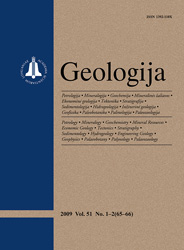Geologija / Geology
 ISSN 1392-110X ISSN 2029-056X (online) |
2007 m. Nr. 4 Results of heavy mineral pre-concentration by the Knelson for the geochemical study of soil: a case study in Lithuania
Heavy minerals (HM) are important bearing phases of many trace elements in soils, glacial and water sediments. They can be used as indicators of different geochemical processes and as a basis to reveal the regional trends of the climate and ecosystem changes during the last glacial–interglacial cycle and the postglacial time. A geochemical study of the Lithuanian soil required representative concentrates of HM with d > 3 g/cm3 in the middle sand fraction (0.25–0.5 mm) and fine sand fraction (0.1–0.25 mm). As voluminous soil samples were needed to be processed, a Knelson Concentrator was used.
The basic idea of the present study was to find out if a Knelson Concentrator could be used to pre-concentrate soil samples and how representative the HM fraction (d > 3 cm/g3) would be in a size range of 0.1–0.5 mm. The soil samples were taken from horizon A1. Every initial sample was divided into two subsamples, which were processed differently. The first subsample of 60 kg was wet screened to a < 2 mm fraction and pre-concentrated by the Knelson (KPS – Knelson pre-concentrated sample). The second subsample of 10 kg was directly separated by wet sieving without pre-concentrating (DSS – directly separated sample). Both subsamples were subjected to heavy liquid separation, dry sieved and analyzed for mineral distribution using SEM-EDS. The results from the DSS showed a naturally occurring content and the proportions of HM in the initial sample, except for some trace HM in the middle sand fraction. They also showed that garnet – mostly almandine (d 4.1 g/cm3) – is originally more abundant than amphibole – predominantly hornblende (d 3.2 g/cm3) – in the fractions studied. However, a significantly higher garnet content and lower amphibole content were reported in the KPS when compared to the DSS. The heavier garnets were preferentially pre-concentrated over the lighter amphiboles. Not only the density, but also the size of the minerals was an important factor. Because a number of HM (e. g., zircon, xenotime, rutile and monazite) tend to occur as fine-grained crystals, a higher content of these minerals was recovered in the fine sand fraction than in the coarser fraction. As the grain size decreased, recovery shifted more than expected towards denser and more spherical HM types. There was a marked increase in the differences in recoveries between HM of the higher and lower density in the 0.1–0.25 mm fraction. The grain size distribution of the soil and especially the proportion of > 0.25 mm fraction and the HM content of the grain fractions were factors affecting the results of Knelson pre-concentration. Raktažodžiai: heavy mineral, Knelson Concentrator, recovery, wet sieving, heavy liquid separation, mineral distribution, soil |
Issues:
2011 - Vol.53 No. 1, No. 2, No. 3 2010 - Vol.52 No. 1-4 2009 - Vol.51 No. 1-2, No. 3-4 2008 - Vol.50 No. 1, No. 2, No. 3, No. 4, No. Priedas 2007 No. 1, No. 2, No. 3, No. 4 2006 No. 1, No. 2, No. 3, No. 4 2005 No. 1, No. 2, No. 3, No. 4 2004 No. 1, No. 2, No. 3, No. 4 2003 No. 1, No. 2, No. 3, No. 4 2002 No. 1, No. 2, No. 3, No. 4 2001 No. 1, No. 2, No. 3, No. 4 |